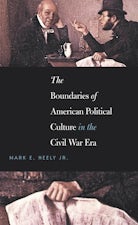Defining Duty in the Civil War
Personal Choice, Popular Culture, and the Union Home Front
By J. Matthew Gallman
336 pp., 6.125 x 9.25, 69 halftones, notes, bibl., index
-
Paperback ISBN: 978-1-4696-3341-1
Published: February 2017 -
E-book PDF ISBN: 979-8-8908-4279-4
Published: May 2015 -
E-book EPUB ISBN: 978-1-4696-2100-5
Published: May 2015
Civil War America
Buy this Book
- Paperback $32.50
- E-Book $19.99
For Professors:
Free E-Exam Copies
Awards & distinctions
2016 Bobbie and John Nau Book Prize in American Civil War Era History, John L. Nau III Center for Civil War History
Silver Medal, 2015 Florida Book Awards in General Nonfiction
2017 Governor John Andrew Award for Civil War History, Seven and Eight Park Street Foundation of the Union Club of Boston
A Civil War Monitor Best Book of 2015
Examining the breadth of Northern popular culture, J. Matthew Gallman offers a dramatic reconsideration of how the Union's civilians understood the meaning of duty and citizenship in wartime. Although a huge percentage of military-aged men served in the Union army, a larger group chose to stay home, even while they supported the war. This pathbreaking study investigates how men and women, both white and black, understood their roles in the People's Conflict. Wartime culture created humorous and angry stereotypes ridiculing the nation's cowards, crooks, and fools, while wrestling with the challenges faced by ordinary Americans. Gallman shows how thousands of authors, artists, and readers together created a new set of rules for navigating life in a nation at war.
About the Author
J. Matthew Gallman is professor of history at the University of Florida and the author of Receiving Erin’s Children: Philadelphia, Liverpool and the Irish Famine Migration, 1845-1855.
For more information about J. Matthew Gallman, visit
the
Author
Page.
Reviews
"A splendid book. Gallman is a shrewd historian.”--Civil War Monitor
“Recommended.”--Choice
“A remarkable, complex, and confident exposition of a world at war, in which individuals found themselves caught between the complacencies of antebellum class, gender, and racial certainties and the challenges of a changed future, a world whose cultural echoes persisted well past 1865.”--American Historical Review
“Investigates how the folks back home . . . came to understand their proper social roles in the ‘People’s Conflict’ through the print media. . . . Well-researched and well-presented.”--Journal of American History
"I highly recommend this book to anyone interested in the American Civil War. I say that because this book handles some of the issues of the home front unlike any book I have read before. . . . His research is phenomenal, his writing is engaging, and the reader is never left confused." --Matthew Bartlett, Gettysburg Chronicle
"Both an enjoyable read and one that expands our understanding of the public discourses occurring on the Union home front."--Journal of Military History
Multimedia & Links
Listen: Gallman talks to Gerald Prokopowicz for the Civil War Talk Radio podcast. (9/30/2015)




